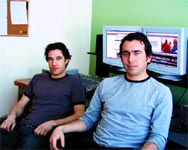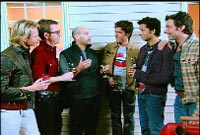NEW YORK - Charged with giving hope to clueless and style-challenged heterosexuals, the witty and urbane Fab Five from Queer Eye for the Straight Guy display boundless energy and good humor. Those attributes are shared by the hardworking video and audio post teams that bring The Fab Five's makeovers to fans eagerly awaiting the next episode of the feel-good reality hit.
Produced by Bravo and Scout Productions www.scoutvision.com/of Boston and New York, Queer Eye is currently airing its third cycle of programs on Bravo cable and NBC. Shot primarily with two Sony DSR-570 DVCAM cameras, each episode unfolds over a four-day period. Sony PD-150 Mini DV cameras are also used to capture action in close quarters such as closets and bathrooms.
THE EDITING

Editors Brad Holmes and Michael LaHaie (L-R) cut Queer Eye on Media Composer Meridiens.
|
Five to six weeks are devoted to offlining each episode. "We wish it was longer," says supervising producer Lynn Sadofsky. The pace of the series is rapid: There may be as many as 1,000 cuts in a 45-minute episode. "There's an overall sense of urgency - The Fab Five running out of their car and into the straight guy's house, racing into stores - and that's reflected in the way we edit," she notes.
Post production offices for Queer Eye are on the premises of New York City's Postworks www.pwny.com/, which handles the offline (Avid Media Composer Meridiens), online (Avid Symphony) and color correction (da Vinci 2K).
The show is unscripted. "You never know what you're going to get in the field," explains post production associate producer Hayli Halper. "But after the shoot the directors give the editors a fleshed out outline with story points they feel are the strongest to focus on." That helps the editors sort through as much as 25 hours of multicam footage.
For senior editors Brad Holmes and Michael LaHaie, the first act poses the biggest challenge. "It's making order out of chaos," says Holmes. "We have to set up the entire show in 10 minutes: introduce The Fab Five, introduce the straight guy and his story, explore the house, set up the rest of the story. And there are lots of continuity issues: We have to create a realtime environment with everyone in the house at the same time, giving each of The Fab Five their moments, while avoiding any sort of jump cuts from room to room. And on top of that, we have to strike a balance between the humor, the emotion and the story."
"I've never cut something that's such a house of cards, something that can fall apart if you lose one shot," notes LaHaie. "The show really engages you as an editor with the creative challenge of that first act." Because there's not enough time to explore all the options, "you have to make decisions with confidence and move on," he emphasizes.

The Fab Five and a straight guy (in black vest): Postworks edits and Sync Sound provides audio post.
|
Postworks' colorist, Eric Alvarado, performs tape-to-tape color correction with a da Vinci 2K. Previous cycles of shows were color corrected in Symphony. "We're very happy that we've been able to begin color correcting in the da Vinci," says Sadofsky. "It's amazing the amount of control you have with it" to deal with location lighting issues.
Conforming in Avid Symphony, usually with Postworks editor Chris Mole, is "fairly seamless," Holmes reports. Mole also incorporates Adobe After Effects graphics.
THE AUDIO POST
Viewers tend to think Queer Eye is a music-intensive series but LaHaie believes "it may be less music driven than other one-hour shows because we don't use wallpaper music. But people do notice our music more." Episodes feature music by Widelife, including variations on their main title theme and licensed pop music appropriate to the straight guy and his story.
Manhattan's Sync Sound has done the series' audio post since its debut. "The producers of Queer Eye are very sound conscious," says mixer/partner Ken Hahn.
That's no mean feat when there may be as many as six mics open at any time recording to TASCAM DA-88. "Part of the fun is the banter and quips," Hahn reminds us. "It's all in the timing and delivery."
The Fab Five's car is outfitted with hidden mics, and body mics accompany straight guys getting their hair cut and their bodies tanned. Hahn and colleagues Tony Pipitone, James Redding and Grant Maxwell use Digidesign Pro Tools' EQ and filtering to eliminate the hits, pops and clicks inherent in body mics. They dip into their bag of tricks to give perspective to participants' voices, which might otherwise sound flat with the plethora of body mics.
After receiving the video editors' OMFs with eight channels of audio, Hahn and crew edit the sound in Pro Tools 5.3 and mix with Digi's ProControl surface or AMS Neve Logic 2, depending on the engineer. Keen on maintaining the energy established by the video edit, they dig up extra sound from off camera, finesse and polish the music and add custom organic sound design to transitions between acts and before-and-after shots. The stereo mix is laid back to Digi Beta for broadcast.
"Queer Eye is one of the most difficult shows I've ever worked on," concludes Holmes. "It's a real challenge, but the reward is great."